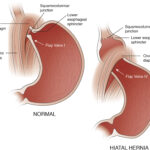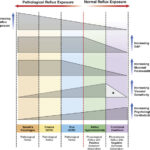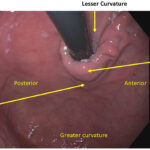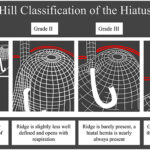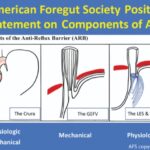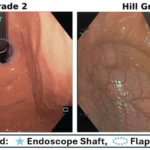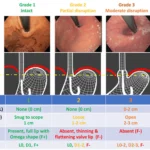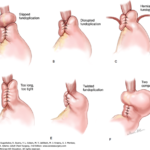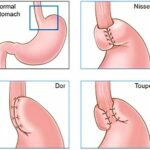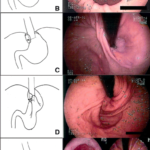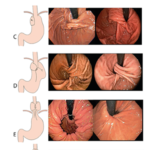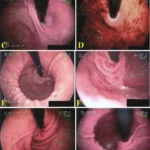Oesophagus and stomach
The oesophagus' role is to transport food from the mouth to the stomach. A closed sphincter valve between the oesophagus and stomach relaxes as food approaches allowing the food to pass through it into the stomach. The stomach job is to accept and store this food and then produce stomach acid and other digestive juices to break the food down into smaller, easier to digest fragments. The acid also kills bacteria contained in the swallowed food or saliva. Muscles in the wall of the stomach help to mix thoroughly the food and acid and finally push the partly-digested food down towards the small intestine. Some conditions of the upper digestive tract are included below:
Achalasia and oesophageal motility disorders
In achalasia and other oesophageal motility disorders, the coordinated transportation of food from the mouth to the stomach is disrupted. This leads to symptoms of food regurgitation, chest pain or heartburn, pain when swallowing or the feeling of a permanent lump in the throat. Dietary modifications and several medications can help relieve symptoms, and some disorders can be improved with oesophageal dilatation or botuliinum toxin via endoscopy or surgery.
Barrett’s Oesophagus
Oesophageal and Stomach (Gastric) Cancer
Oesophageal and stomach cancers are malignant tumours found in the tissues of the oesophagus and stomach. They are two separate cancers that can develop in any part of either organ. There are different types of both cancers. They are usually slow growing over many years before any symptoms are felt. Treatment depends on their stage.
Heartburn (Gastro-oesophageal Reflux)
Gastro-oesophageal reflux occurs when the stomach contents, usually acid, backwashes into the oesophagus. Disturbing symptoms include heartburn, acid brash, indigestion, persistent cough, and swallowing problems. It is common. When symptoms interfere with daily life, most can get relief with lifestyle changes and over-the-counter treatments. Some need stronger medications or even surgery.
Gastro-oesophageal reflux disease (GORD) is a complex condition resulting from the retrograde flow of gastric contents into the oesophagus. The severity of GORD is influenced by a balance between reflux exposure, epithelial resistance, and visceral sensitivity. Reflux occurs when the anti-reflux barrier, primarily formed by the lower esophageal sphincter (LES) and crural diaphragm, is compromised. This leads to increased reflux events and greater exposure to gastric juice, which can cause damage to the esophageal lining. While acid reflux is a primary factor in esophageal injury, other components of gastric juice, such as bile and pepsin, also contribute to the disease. Complications can arise even with normal reflux levels, particularly when epithelial resistance is low or visceral sensitivity is heightened, so the cause of GORD a dynamic interplay of aggressive and defensive factors.
In addition to the impact of reflux exposure, oesophageal sensitivity plays a key role in the development of symptoms. Some patients with normal reflux exposure experience significant discomfort due to heightened sensitivity, a condition known as reflux hypersensitivity. Factors such as stress, anxiety, and psychosocial comorbidities can exacerbate symptom severity and affect response to treatment. Research into the mechanisms of GORD continues to evolve, with new insights into the roles of mucosal barrier function, sensory nerve sensitivity, and central nervous system processing. Advances in understanding these processes may lead to more effective, personalised treatment strategies for GORD patients in the future.
Eosinophilic oesophagitis (EoE)
EoE is an increasingly recognised oesophageal disorder where the oesophagus is inflamed with an increased number of high specialised immune cells called eosinophils. It commonly causes difficulties swallowing solid food including food impaction, and non-swallowing associated chest pain. It may occur at any age with a peak in 30-5o year old males. Food allergy, hay fever, asthma and eczema are common. Treatment is helpful with topical anti-inflammatories called glucocorticoids, acid suppression, food elimination diets and endoscopic dilatation of narrowings where medications is unhelpful. Monitoring is mainly done with biopsy after 6-12 weeks of treatment as symptoms correlate poorly with the severity of inflammation. There is no association or link to cancer. See below links for:
Mistakes in EO and how to avoid them
Swallowing Disorders
With careful assessment, most swallowing disorders can be clarified and treated. Often speech therapy, lifestyle change or medication is enough. Occasionally oesophageal dilatation, "Botox" injection, surgery or percutaneous feeding gastroscopy is required.
Disorders of Gut-Brain Interaction
Functional Oesophageal Disorders
- Functional Chest Pain
Recurring, unexplained chest pain behind the sternum that is not experienced as heartburn but is believed to be related to the esophagus. Heart disease should be excluded by medical evaluation or cardiac diagnostic studies.
- Functional Heartburn
Burning discomfort or pain that is experienced behind the breastbone (retrosternal) that does not respond to acid-blocking treatments and is not caused by any structural diagnosis or motility disorder.
- Reflux Hypersensitivity
Heartburn or chest pain when endoscopy and pH studies are normal, but symptoms occur when acid enters the esophagus. Esophageal PH testing shows no increased acid, but the esophagus is found to be sensitive to acid. https://romedross.video/2FtbM1H
- Globus
Persistent or intermittent non-painful sensation of having a lump or foreign body in the throat. It occurs episodically and is located in the midline above the sternal notch.
- Functional Dysphagia
Sense of solid or liquid foods sticking, lodging, or passing abnormally through the esophagus. https://romedross.video/2M8N5ez
Gastroduodenal Disorders
Functional Dyspepsia
Any of the following apply:
- The unpleasant sensation of food staying in the stomach after a meal ("postprandial fullness");
- the unpleasant feeling that the stomach is overfilled soon after starting to eat ("early satiety");
- subjective, intense pain in the area just above the stomach ("epigastric pain") and/or
- unpleasant, subjective sensation of heat in the epigastrium. These symptoms significantly impact usual activities. There are two subtypes of functional dyspepsia. They may overlap. https://romedross.video/36uTGaA :
- Postprandial Distress Syndrome (PDS)
Uncomfortable sensation of being too full soon after eating a meal or becoming full so early that eating a regular-sized meal is prevented. PDS is characterized exclusively by meal-induced symptoms.
- Epigastric Pain Syndrome (EPS)
Epigastric pain or burning that does not occur exclusively after meals, may occur during fasting, and may be improved by food.
Belching Disorders
The audible escape of air from the esophagus or the stomach into the pharynx. This is only considered a disorder when it is excessive and becomes troublesome. Belching disorders are sub-classified into:
- Excessive Supragastric Belching (from esophagus): excessive belching that occurs more than 3 days a week, caused by gas that originates from the stomach.
- Excessive Gastric Belching (from stomach): excessive belching that occurs more than 3 days a week, caused by gas that originates from the stomach. See B2, above, for a fuller description.
Nausea and Vomiting Disorders
Nausea is the unpleasant sensation of needing to vomit, typically felt in the upper abdomen immediately above the stomach, or in the throat (see B3a below). Vomiting is the forceful oral expulsion of gastrointestinal contents associated with contraction of the abdominal and chest wall muscles (see B3b below). http://bit.ly/2wW5hiD
- Chronic Nausea Vomiting Syndrome (CNVS)
Nausea occurring at least one day a week that is severe enough to impact usual activities, and one or more vomiting episodes a week. Eating disorders and self-induced vomiting must be excluded, and tests (including an upper endoscopy) find no evidence of organic abnormality. http://bit.ly/2wW5hiD
- Cyclic Vomiting Syndrome (CVS)
Intermittent stereotypical episodes of intense vomiting (up to 30 times a day) that may occur multiple times a year, lasting for a week or more, and the absence of nausea and vomiting between episodes http://bit.ly/2wW5hiD
- Cannabinoid Hyperemesis Syndrome (CHS)
Episodes of vomiting similar to CVS in their onset, duration, and frequency, but they occur after prolonged, excessive cannabis use and stop when cannabis use is discontinued. https://romedross.video/2FtbM1H
- Rumination Syndrome
Repetitive, effortless regurgitation of recently eaten food into the mouth, which is then re-swallowed or spit out. Regurgitation is not preceded by retching and occurs before the food has turned into acid. https://theromefoundation.org/q-a-rumination-2/
Gastroparesis
Gastroparesis is a disorder of the nerves or muscles of upper digestive tract where the stomach cannot empty itself of food and liquids in the normal way. Symptoms include feeling sick, nauseated, full or bloated when eating, vomiting, pain in the upper abdomen and weight loss. The diagnosis is not always easy and tests to confirm the diagnosis may include Xrays, gastroscopy, nuclear medicine tests of gut motility and function and on occasions a test called antroduodenal manometry. The cause is not found in nearly half of cases. Other causes include diabetes (nearly 25%), postviral/infectious states, connective tissue or autoimmune disorders, prior stomach surgery, poor blood circulation to the upper digestive tract (so called ischaemia) and medications. Gastroparesis patients show diverse changes in function of the upper digestive tract including abnormal muscle tone in the upper stomach (abnormal fundic tone), poor coordination of muscle contractions within the stomach and then between stomach and duodenum (gastric dysrhythmias and antroduodenal dyscoordination, impair duodenal feedback), decrease strength of the muscle waves which emptying the stomach (weak antral pump). Treatments including diet changes, medications to accelerate gastric emptying or against nausea and vomiting, pyloric botox or dilation. In some tough cases, Xray or endoscopic procedures including small bowel feeding tubes via the nose or through the abdominal skin. As these tubes passing via the stomach into the small bowel may be disrupted by vomiting. other novel techniques may be needed if nutrition is suffering. In some cases, Dr Samuel uses a novel minimally invasive double balloon enteroscopy assisted technique to bypass the stomach and place feeding jejunal tubes directly through the skin (direct PEJ). In other cases patients are referred for surgical procedures including stomach pacemakers to provide relief of symptoms and help with nutrition. With a tailor approach symptoms, nutrition and quality of life can be significantly improved.
Peptic Ulcers and Helicobacter pylori
Peptic ulcers were once a common and hard to treat cause of indigestion and pain. Today, in many, H pylori stomach infection is found. With a short course of treatment most can be cured. When H pylori gastritis is not cured with simple antibiotics, several other treatments can be highly effective.

